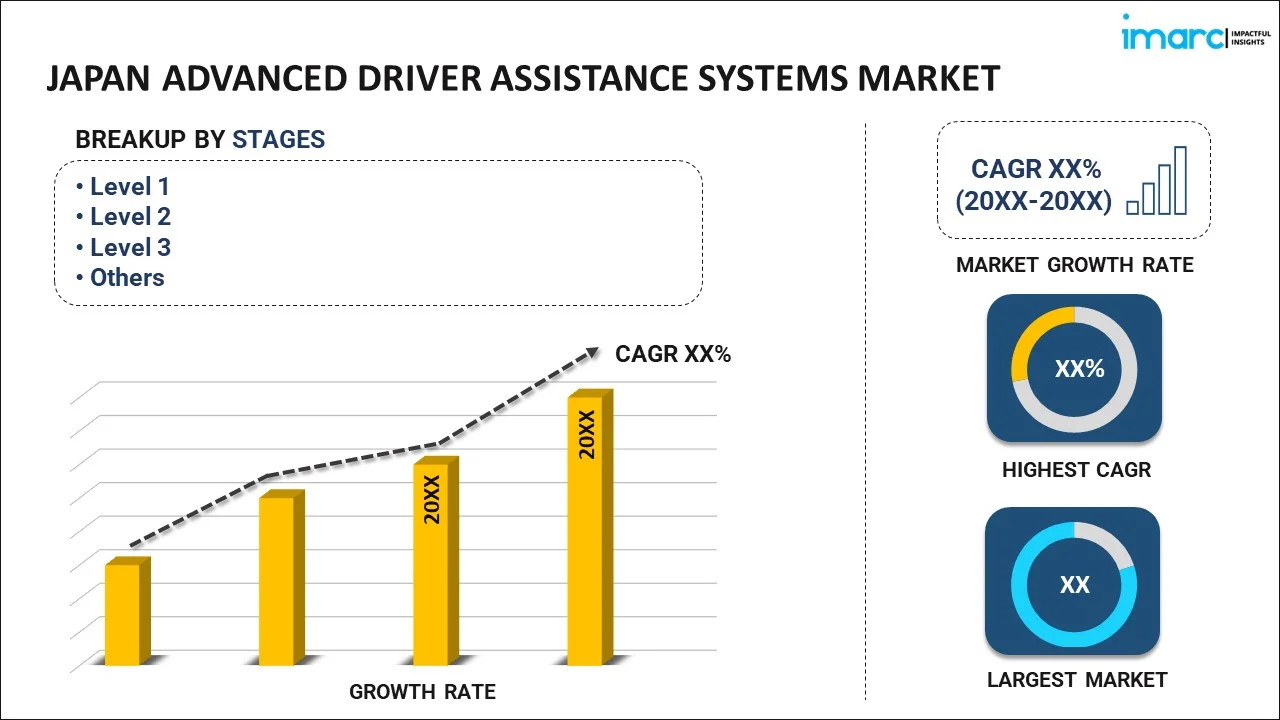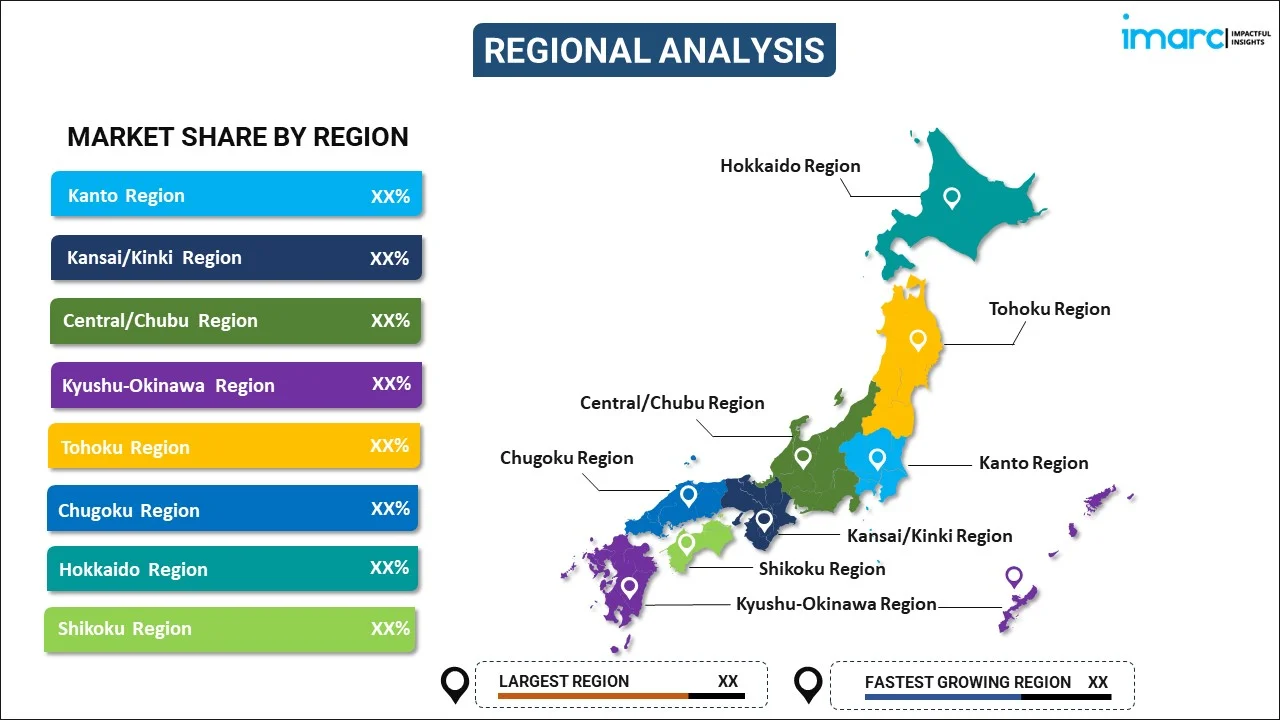
Japan Advanced Driver Assistance Systems Market Report by Stage (Level 1, Level 2, Level 3, Level 4, Level 5), System Type (Passive ADAS System, Active ADAS System), Sensor Type (Lidar Sensor, Ultrasonic Sensor, Radar Sensor, Camera Sensor, and Others), Vehicle Type (ICE Vehicle, Electric/Hybrid Vehicle), and Region 2025-2033
Market Overview:
Japan advanced driver assistance systems market size reached USD 1,833.0 Million in 2024. Looking forward, IMARC Group expects the market to reach USD 6,510.0 Million by 2033, exhibiting a growth rate (CAGR) of 15.1% during 2025-2033. The market is being driven by several significant factors, including the enforcement of strict safety regulations, a rising number of road accidents, rapid technological advancements, and an increasing demand for improved driving comfort and safety features.
|
Report Attribute
|
Key Statistics
|
|---|---|
|
Base Year
|
2024 |
|
Forecast Years
|
2025-2033
|
|
Historical Years
|
2019-2024
|
| Market Size in 2024 | USD 1,833.0 Million |
| Market Forecast in 2033 | USD 6,510.0 Million |
| Market Growth Rate (2025-2033) | 15.1% |
Advanced driver assistance systems (ADAS) encompass advanced technological solutions integrated into vehicles to elevate safety and enhance the driving experience. These solutions encompass features such as lane departure warnings, automatic emergency braking, adaptive cruise control, and parking assistance. ADAS systems consist of an array of components, including cameras, sensors, artificial intelligence (AI) algorithms, and other elements, which collaborate to collect, interpret, and respond to real-time data from the vehicle and its surroundings. Advanced driver assistance systems technology serves various purposes, including collision avoidance, pedestrian detection, traffic sign recognition, blind-spot monitoring, and identifying drowsy drivers. These systems contribute to reducing road fatalities, improving traffic flow, reducing fuel consumption, and mitigating carbon dioxide emissions.
Japan Advanced Driver Assistance Systems Market Trends:
The market in Japan is primarily being propelled by substantial growth within the automotive sector. This growth can be attributed to the increasing population and the rising disposable incomes among individuals, leading to a significant uptick in the adoption of vehicles equipped with advanced safety systems, including advanced driver assistance systems, on a wide scale. Additionally, the escalating issue of traffic congestion and the growing incidence of accidents worldwide are further stimulating market expansion. Besides this, authorities in Japan have either enforced or strongly recommended the adoption of specific ADAS technologies because of their demonstrated effectiveness in mitigating road accidents. These mandates encompass prerequisites for systems like electronic stability control, lane departure warnings, pedestrian detection, collision detection, and automatic emergency braking. Furthermore, various governments across multiple countries are taking proactive measures to enhance vehicle safety, with the aim of reducing road accidents, which is acting as another significant growth-inducing factor. These initiatives include promoting the adoption of driverless and automated vehicles equipped with advanced driver assistance systems, thereby fostering a positive market outlook. Other factors encompass rapid urbanization and the increasing adoption of luxury vehicles, which is expected to propel the regional market over the forecasted period.
Japan Advanced Driver Assistance Systems Market Segmentation:
IMARC Group provides an analysis of the key trends in each segment of the market, along with forecasts at the country level for 2025-2033. Our report has categorized the market based on stage, system type, sensor type, and vehicle type.
Stage Insights:

- Level 1
- Level 2
- Level 3
- Level 4
- Level 5
The report has provided a detailed breakup and analysis of the market based on the stage. This includes level 1, level 2, level 3, level 4, and level 5.
System Type Insights:
- Passive ADAS System
- Active ADAS System
A detailed breakup and analysis of the market based on the system type have also been provided in the report. This includes passive ADAS system and active ADAS system.
Sensor Type Insights:
- LiDAR Sensor
- Ultrasonic Sensor
- Radar Sensor
- Camera Sensor
- Others
The report has provided a detailed breakup and analysis of the market based on the sensor type. This includes LiDAR sensor, ultrasonic sensor, radar sensor, camera sensor, and others.
Vehicle Type Insights:
- ICE Vehicle
- Electric/Hybrid Vehicle
A detailed breakup and analysis of the market based on the vehicle type have also been provided in the report. This includes ICE vehicle and electric/hybrid vehicle.
Regional Insights:

- Kanto Region
- Kansai/Kinki Region
- Central/ Chubu Region
- Kyushu-Okinawa Region
- Tohoku Region
- Chugoku Region
- Hokkaido Region
- Shikoku Region
The report has also provided a comprehensive analysis of all the major regional markets, which include Kanto Region, Kansai/Kinki Region, Central/ Chubu Region, Kyushu-Okinawa Region, Tohoku Region, Chugoku Region, Hokkaido Region, and Shikoku Region.
Competitive Landscape:
The market research report has also provided a comprehensive analysis of the competitive landscape in the market. Competitive analysis such as market structure, key player positioning, top winning strategies, competitive dashboard, and company evaluation quadrant has been covered in the report. Also, detailed profiles of all major companies have been provided.
Japan Advanced Driver Assistance Systems Market Report Coverage:
| Report Features | Details |
|---|---|
| Base Year of the Analysis | 2024 |
| Historical Period | 2019-2024 |
| Forecast Period | 2025-2033 |
| Units | Million USD |
| Scope of the Report | Exploration of Historical and Forecast Trends, Industry Catalysts and Challenges, Segment-Wise Historical and Predictive Market Assessment:
|
| Stages Covered | Level 1, Level 2, Level 3, Level 4, Level 5 |
| System Types Covered | Passive ADAS System, Active ADAS System |
| Sensor Types Covered | Lidar Sensor, Ultrasonic Sensor, Radar Sensor, Camera Sensor, Others |
| Vehicle Types Covered | ICE Vehicle, Electric/Hybrid Vehicle |
| Regions Covered | Kanto Region, Kansai/Kinki Region, Central/ Chubu Region, Kyushu-Okinawa Region, Tohoku Region, Chugoku Region, Hokkaido Region, Shikoku Region |
| Customization Scope | 10% Free Customization |
| Post-Sale Analyst Support | 10-12 Weeks |
| Delivery Format | PDF and Excel through Email (We can also provide the editable version of the report in PPT/Word format on special request) |
Key Questions Answered in This Report:
- How has the Japan advanced driver assistance systems market performed so far and how will it perform in the coming years?
- What has been the impact of COVID-19 on the Japan advanced driver assistance systems market?
- What is the breakup of the Japan advanced driver assistance systems market on the basis of stage?
- What is the breakup of the Japan advanced driver assistance systems market on the basis of system type?
- What is the breakup of the Japan advanced driver assistance systems market on the basis of sensor type?
- What is the breakup of the Japan advanced driver assistance systems market on the basis of vehicle type?
- What are the various stages in the value chain of the Japan advanced driver assistance systems market?
- What are the key driving factors and challenges in the Japan advanced driver assistance systems?
- What is the structure of the Japan advanced driver assistance systems market and who are the key players?
- What is the degree of competition in the Japan advanced driver assistance systems market?
Key Benefits for Stakeholders:
- IMARC’s industry report offers a comprehensive quantitative analysis of various market segments, historical and current market trends, market forecasts, and dynamics of the Japan advanced driver assistance systems market from 2019-2033.
- The research report provides the latest information on the market drivers, challenges, and opportunities in the Japan advanced driver assistance systems market.
- Porter's five forces analysis assist stakeholders in assessing the impact of new entrants, competitive rivalry, supplier power, buyer power, and the threat of substitution. It helps stakeholders to analyze the level of competition within the Japan advanced driver assistance systems industry and its attractiveness.
- Competitive landscape allows stakeholders to understand their competitive environment and provides an insight into the current positions of key players in the market.
Need more help?
- Speak to our experienced analysts for insights on the current market scenarios.
- Include additional segments and countries to customize the report as per your requirement.
- Gain an unparalleled competitive advantage in your domain by understanding how to utilize the report and positively impacting your operations and revenue.
- For further assistance, please connect with our analysts.
 Inquire Before Buying
Inquire Before Buying
 Speak to an Analyst
Speak to an Analyst
 Request Brochure
Request Brochure
 Request Customization
Request Customization




.webp)




.webp)












